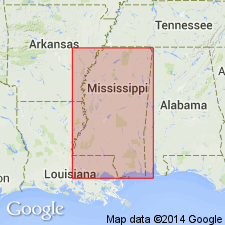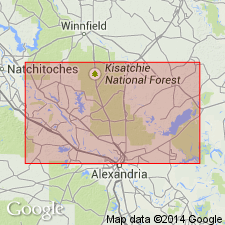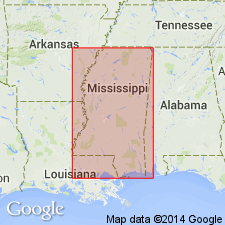
- Usage in publication:
-
- Grand Gulf group
- Modifications:
-
- Original reference
- Dominant lithology:
-
- Clay
- Sand
- AAPG geologic province:
-
- Mid-Gulf Coast basin
Summary:
Pg. 108, 147-154. Grand Gulf group (also Grand Gulf stage, or Southern Lignitic). White or gray sandstone, usually soft; black, blue, green, and gray clays and sands, with small lignite beds, tree palms, exogenous trees, and ARUNDINACEAE. Thickness 150 feet. Includes, at top, Grand Gulf sandstone proper, 14 feet thick. Overlain by Newer Tertiary(?) clays of the coast, and underlain by Vicksburg group. [Age is Oligocene(?) and Miocene.]
[Named from development of its principal member (Grand Gulf sandstone proper) in bluff at Grand Gulf, Claiborne Co., MS.]
Source: US geologic names lexicon (USGS Bull. 896, p. 853).

- Usage in publication:
-
- Grand Gulf group
- Modifications:
-
- Revised
- AAPG geologic province:
-
- Mid-Gulf Coast basin
Summary:
Grand Gulf sandstone at the top of the Grand Gulf group replaced by term Catahoula sandstone, because of varied and conflicting uses.
Source: GNU records (USGS DDS-6; Reston GNULEX).

- Usage in publication:
-
- Grand Gulf group†
- Modifications:
-
- Abandoned
- AAPG geologic province:
-
- Mid-Gulf Coast basin
Summary:
†Grand Gulf group. As described and used in different areas included Catahoula sandstone, Hattiesburg clay, and Pascagoula clay, and the use of the name has been discontinued.
Source: US geologic names lexicon (USGS Bull. 896, p. 853).

- Usage in publication:
-
- Grand Gulf group
- Modifications:
-
- Reinstated
- Revised
- AAPG geologic province:
-
- Mid-Gulf Coast basin
Summary:
Pg. 138-174. Term Grand Gulf group revived. Considered to include all sediments exposed in central Louisiana from Vicksburg Oligocene to southernmost exposures of Tertiary sediments in Rapides Parish. As thus defined, includes Catahoula and Fleming formations. [Age is Miocene.]
Source: US geologic names lexicon (USGS Bull. 1200, p. 1564-1565).

- Usage in publication:
-
- Grand Gulf group
- Modifications:
-
- Areal extent
- AAPG geologic province:
-
- Mid-Gulf Coast basin
Summary:
[Chart originally published in Mississippi Geol. Soc. Gdbk. 1, Feb. 1940; revised chart published in AAPG Bull. (submitted Oct. 1940).] Authors included in Grand Gulf group (ascending) the Bucatunna clay, Chickasawhay (lower and upper), Catahoula sand, Hattiesburg clay, and Pascagoula clay. Occurs above Vicksburg group [boundary between Oligocene and Miocene is queried, and Bucatunna and Chickasawhay may be considered part of Vicksburg group].
Revised chart published in AAPG Bull. (submitted Oct. 1940) shows Grand Gulf group comprised of (ascending) Catahoula sand, Hattiesburg clay, and Pascagoula clay. [The Bucatunna and Chickasawhay are treated as formations of the underlying Vicksburg and boundary between the two groups is dashed]. Occurs below Pliocene Citronelle formation. Age is considered Miocene.
Source: Publication; US geologic names lexicon (USGS Bull. 1200, p. 1564-1565).
For more information, please contact Nancy Stamm, Geologic Names Committee Secretary.
Asterisk (*) indicates published by U.S. Geological Survey authors.
"No current usage" (†) implies that a name has been abandoned or has fallen into disuse. Former usage and, if known, replacement name given in parentheses ( ).
Slash (/) indicates name conflicts with nomenclatural guidelines (CSN, 1933; ACSN, 1961, 1970; NACSN, 1983, 2005, 2021). May be explained within brackets ([ ]).

